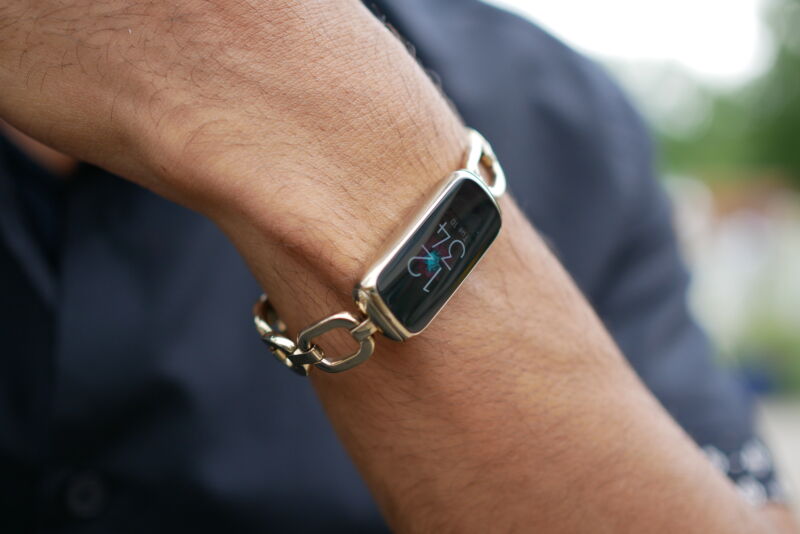
In the game of fitness wearables, it’s hard to give everyone what they want. That’s why Garmin offers a seemingly endless array of watches, Apple currently sells no less than three Apple Watches, and Fitbit has an array of wearables from kid-centric trackers to a smartwatch the company hopes can one day detect early symptoms of COVID-19.
The Fitbit Luxe, which retails for $150, is the latter's latest style-focused fitness tracker. It attempts to provide some smartwatch luxuries in a device that looks like a piece of jewelry. The Luxe is a cute tracker, but it has some questionable choices and oversights to be aware of—most of which are endemic to Fitbit devices.
If you’re looking for an ultracasual fitness tracker and a stylish smart device for your wrist, the Fitbit Luxe could be one of your best options. If you’re looking to get active and stay active, though, you may want to look elsewhere.
It’s stylish, no doubt

Fitbit Luxe
This special edition fetches an extra $50 on top of the Luxe’s base price, or you can buy the link bracelet separately for $100. There are also leather and stainless-steel bands, among others, to choose from.
If style is important to you with this kind of device, you may consider these relatively costly accessories. Otherwise, the $150 base price—a $50 increase over the less opulently equipped but similarly functional Fitbit Inspire 2—may be the sweet spot between style and cost. Not everyone wants an activity tracker that looks like a LIVESTRONG bracelet with a screen.
The Luxe’s vivid, colorful OLED touchscreen is the other major aesthetic difference from the Inspire 2. Compared to the black-and-white OLED of the Inspire, the Luxe screen adds depth and vibrancy with its inky blacks and pops of color when the screen’s on. This contributes to the Luxe’s higher-end look and feel. It is a tiny screen, measuring at less than an inch, but thankfully it doesn’t feel too cramped for reading quick bits of information.
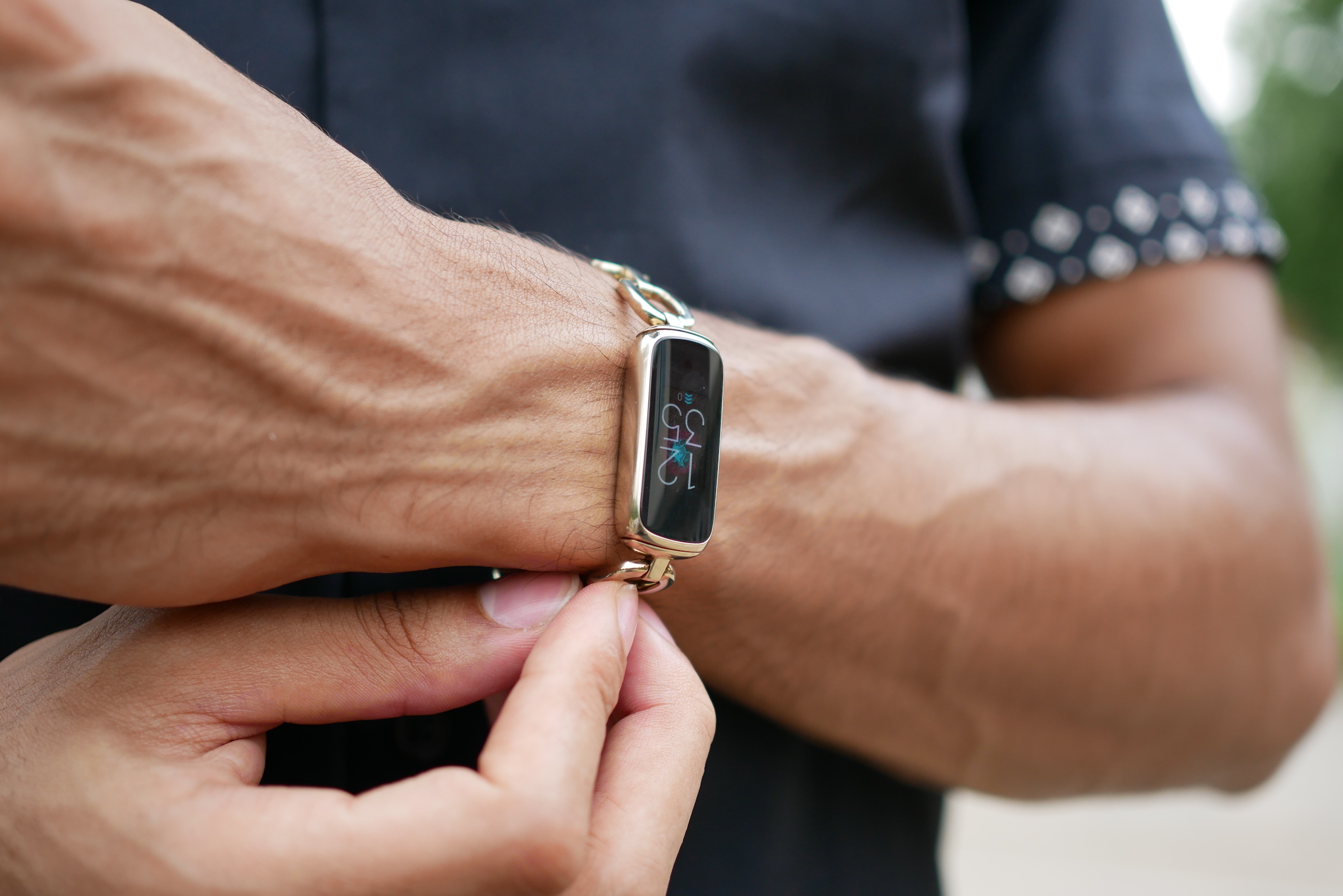 The Fitbit Luxe looks especially stylish with the special edition Gorjana braceletCorey Gaskin
The Fitbit Luxe looks especially stylish with the special edition Gorjana braceletCorey Gaskin It's adjustable and fashionable but costs an extra $50 over the base Luxe with a silicone band.Corey Gaskin
It's adjustable and fashionable but costs an extra $50 over the base Luxe with a silicone band.Corey Gaskin You'll need to swap the silicone band for workouts, as prolonged contact with sweat can discolor the jewelry.Corey Gaskin
You'll need to swap the silicone band for workouts, as prolonged contact with sweat can discolor the jewelry.Corey Gaskin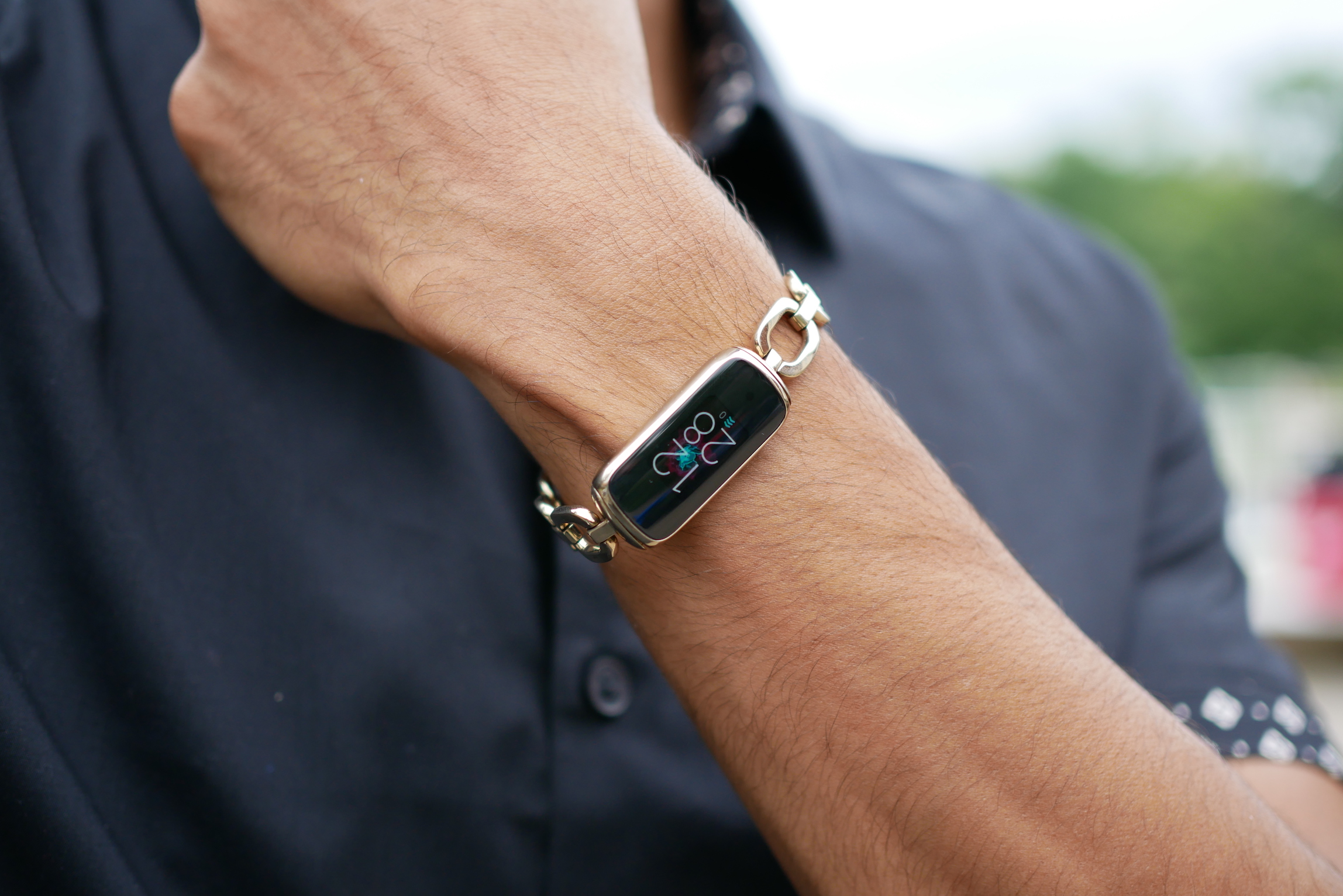 The OLED display provides a nice pop of color.Corey Gaskin
The OLED display provides a nice pop of color.Corey Gaskin And it looks even more like a bracelet with the screen off.Corey Gaskin
And it looks even more like a bracelet with the screen off.Corey Gaskin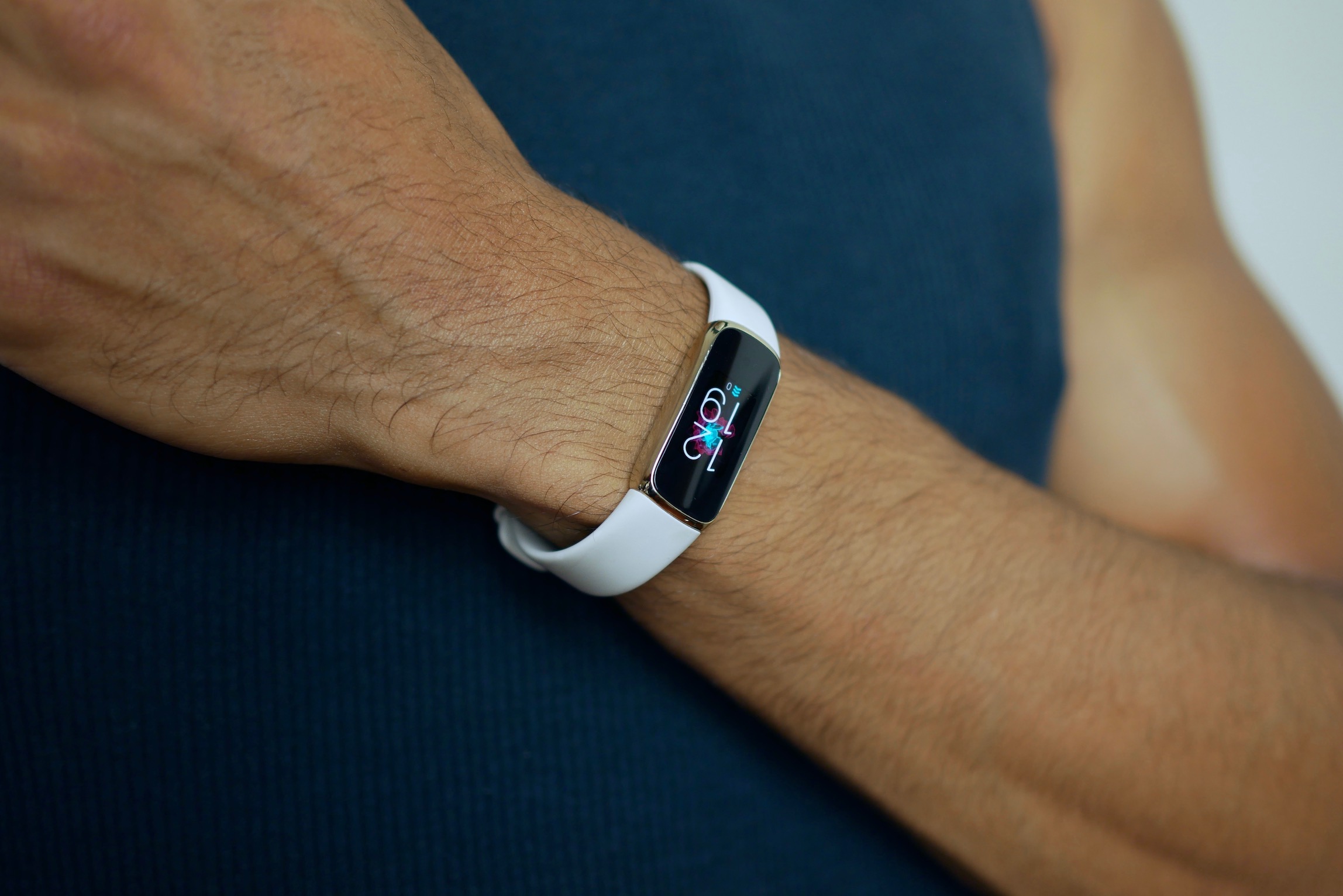 Even with the silicone band, it maintains a versatile aesthetic.Corey Gaskin
Even with the silicone band, it maintains a versatile aesthetic.Corey Gaskin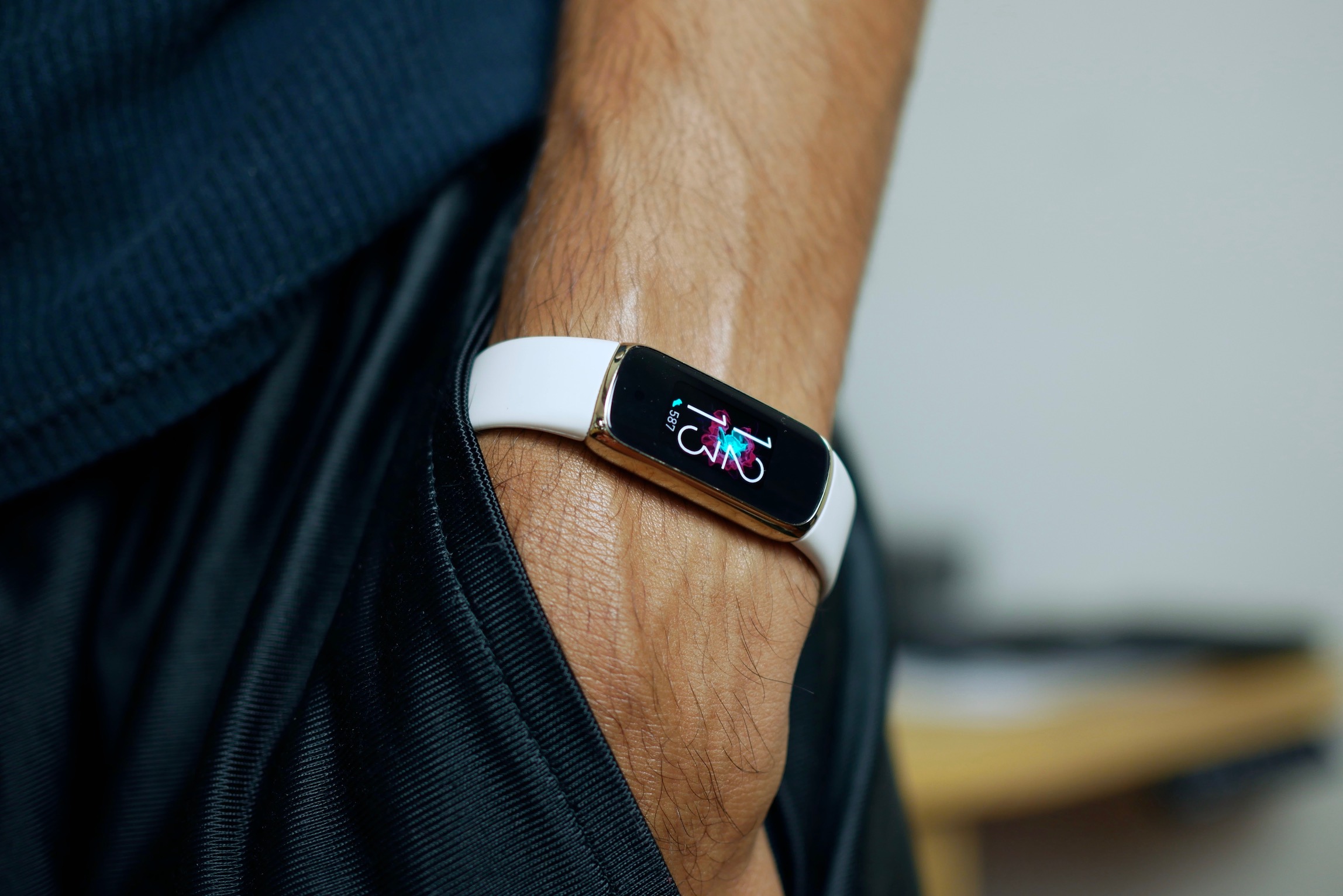 Corey Gaskin
Corey Gaskin
User interface and performance
Where things get a trifle annoying is the Luxe’s user interface. Fitbit’s never been home to the most intuitive wearable UIs, but in melding the simplistic carousel-based UI of typical fitness trackers with more common smartwatch functionalities, Fitbit has done a decent job of keeping things usable. There are some shortcomings, though.
The first thing you’ll notice is the Luxe’s slow reaction to inputs. It’s a full step behind whatever swiping or tapping gesture you’ve made. Whether that’s by design—perhaps to cope with the fact that your finger covers the entire screen as you interact with it—or not, it ultimately feels laggy and cheap. The sluggishness may cause you to double up on inputs, even after you’ve grown accustomed to the delay.
Smaller quirks, like the double-tap gesture required to return to the home screen, take some getting used to. In that case, you have to target the top of the screen in order to avoid errant inputs, but this works well once you've got the hang of it.
The most frustrating oversights deal with exercise functionality. Initiating the swimming activity on the Luxe automatically locks the screen from further inputs until a combination of taps is achieved, but there is no locking option for any other activity. As a boxer, however, this is a function I would rely on heavily.
In fact, this oversight renders the Luxe totally useless for kickboxing, an activity that's preloaded on the tracker by default. Unless you’re shadow kickboxing—i.e., not using a bag and gloves—then this activity mode will constantly trigger inputs within your gloves as it did for me. Nine out of 10 boxing sessions, the Luxe would screw up my tracking by pausing or canceling the activity altogether.
There’s no ability to control your music from the Luxe, either, and there's no way to put an activity-tracking session in the background while doing something else. If you’re midsession and want to check a text or set a timer, you’ll have to end the activity entirely to use any other part of the Luxe’s user interface.
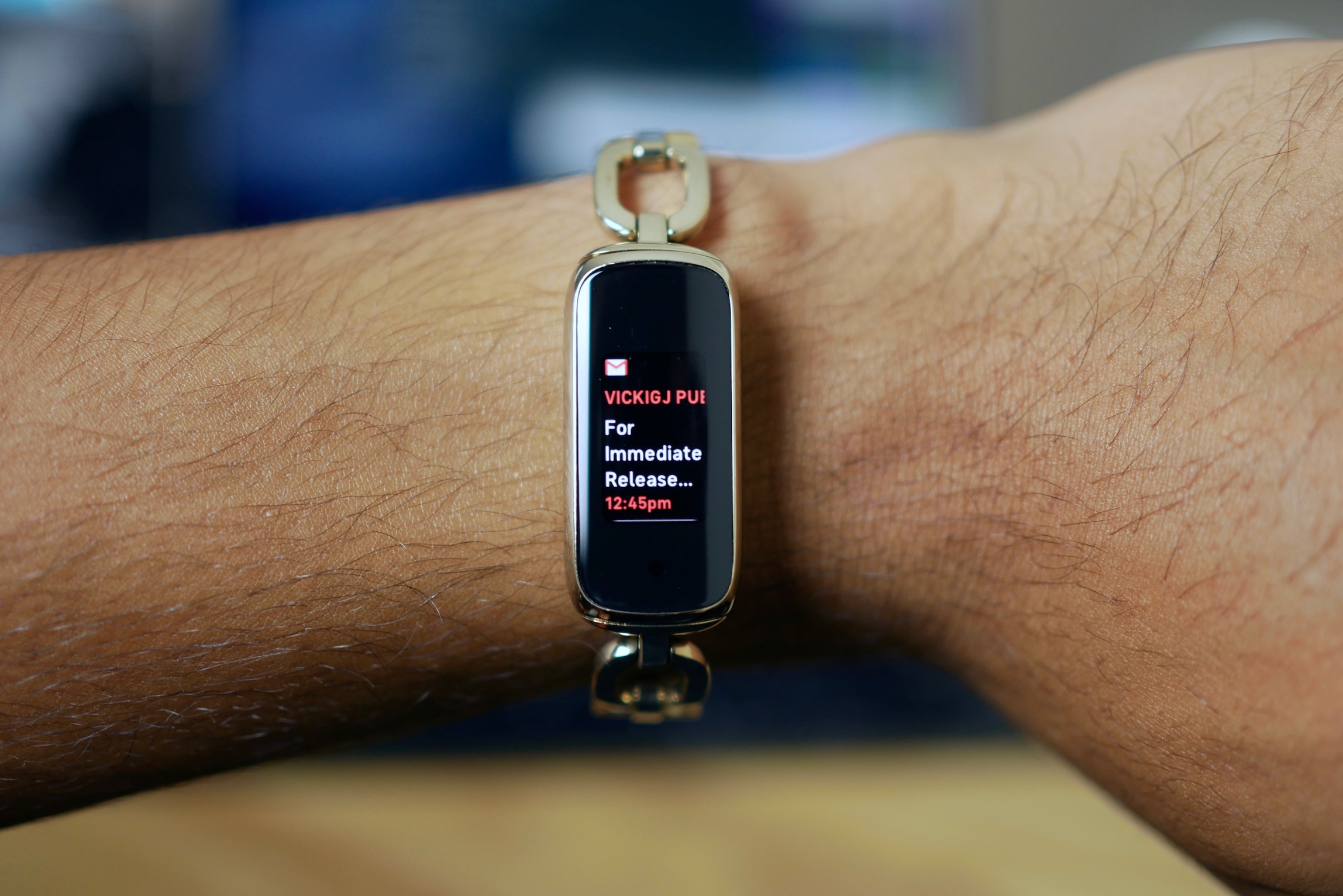 The screen isn't too small to be useful.Corey Gaskin
The screen isn't too small to be useful.Corey Gaskin And quick bits of information are easy to glance at with a tap or scroll.Corey Gaskin
And quick bits of information are easy to glance at with a tap or scroll.Corey Gaskin You must receive a notification for an app before you can allow alerts for it on your Luxe. It's asinine.
You must receive a notification for an app before you can allow alerts for it on your Luxe. It's asinine.
As far as notification handling goes, the Luxe is usable. Since the screen is so small, it’ll require a tap and a scroll or two to read even short messages, but it gets the job done with little fuss. Inanely, though, you must enable notifications for each app, one by one, within the Fitbit app settings. And you can only add an app to the notification whitelist after you’ve set up the Luxe and received at least one notification from the app of interest.
This means that, if you haven’t received a notification from an app since setting up your Luxe, receiving its alerts on your Luxe isn’t even an option. Consequently, you must periodically go into the Fitbit app and check to see which notifications you can whitelist as more apps eventually send you an alert. It’s totally bonkers and borderline punitive.
Still, the Luxe is technically an activity tracker, not a full-featured smartwatch. So, if you like Fitbit’s approach to fitness but want features like music control and a roomier and somewhat smoother UI, perhaps a Fitbit Sense or Versa would be more your speed. Although, these will also force you to suffer the wanton notification setup process, among other issues mentioned above.
Activity and wellness tracking with the Luxe
The Fitbit Luxe has a heart-rate monitor and the ability to track blood oxygen levels, but the latter function has not yet been enabled on the device. The Luxe lacks built-in GPS and an altimeter, but it’s water-resistant up to 50 meters and can track about 20 different exercises, as well as sleep.
Sleep tracking on the Luxe is detailed but overzealous with its wake-up count and the duration of such events. As with any consumer-grade sleep tracker, it’s far from scientific and better suited to merely help you be more mindful of your sleep hygiene and schedule consistency. In that sense, the Luxe can still be useful.
You’ll want to disable the “Smart Track” feature for activities, though. It’s a feature designed to automatically start tracking activities and sports the Luxe recognizes based on your movements and heart rate. In my testing, though, the Luxe was also overeager to track things that weren’t happening.
As for manual tracking, shortcomings in its inability to track my main sport (boxing)—or any activity besides swimming where a touchscreen lock is needed—aside, the Luxe seems to be decently accurate.
Again, neither this nor any consumer smartwatch or activity tracker is a medical device, and all figures are estimates. So you can’t put too much stock in the raw numbers of things like calories burned. By comparison, I tended to find the Luxe on the higher side of these estimates compared to the Apple Watch Series 6 and Garmin Forerunner 945 with HRM Pro heart-rate strap.
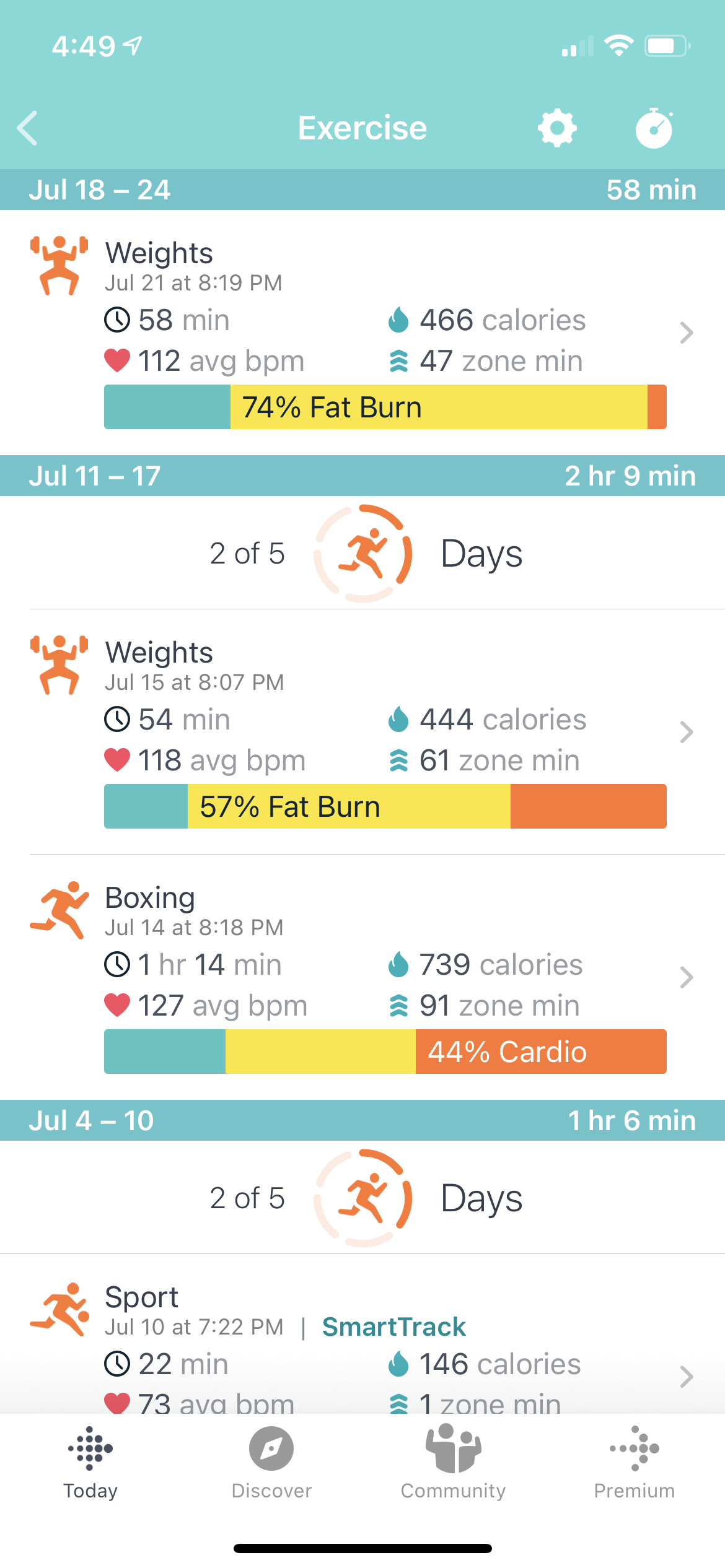 Calorie-burn estimates seemed a tad high sometimes, but they were within range of general estimates.
Calorie-burn estimates seemed a tad high sometimes, but they were within range of general estimates. Your exercises are broken down into heart-rate zones with problematic, misleading names.Fitbit
Your exercises are broken down into heart-rate zones with problematic, misleading names.Fitbit
All three trackers were usually within about a 100-200 calorie range of each other’s estimates. While the Fitbit always had the highest calorie-burn estimate, the Garmin 945 typically had the lowest, and the Apple Watch was usually right in the middle. For the little bit I know about my calorie burn and that of the exercises I was doing, the Garmin estimates often seemed a bit low, which is something other Garmin users have noted as well.
Apple’s data seemed to be the happiest medium for estimation. It tends to be closer to the calorie-burn estimates you’d find from Googling a specific exercise and duration, though that doesn’t mean it’s the most accurate. In general, Fitbit may tend to slightly overestimate your efforts, but not by a disqualifying margin. Heart-rate estimates between all three were consistent, closer in range, and generally accurate, but I do have a bone to pick with how they’re presented in the Fitbit app.
The myth of the “fat burn” heart-rate zone
Heart-rate tracking for activities is mostly meant to give you an idea of how hard you’ve pushed yourself in an exercise. How hard it feels for you is also a consideration, as are your goals. But heart-rate zones can give you some idea of the intensity with which your heart is working.
The Luxe’s heart-rate zones can be used as a guide to get an idea of your workouts' intensity and as a tool to ensure you’re in a specific heart-rate zone. Instead of using the preset zones, users can create a custom target heart-rate zone in the Fitbit app, once you’ve calculated your heart-rate percentages and have a better idea of what level of exertion you’d like to maintain.
Unfortunately, Fitbit doesn't give you the raw numbers of your heart rate throughout an exercise, and it doesn't simply break your workout down into numerical heart-rate zones in its app—say, 60 to 75 percent of your maximum heart rate—like most trackers do. Instead, while it technically charts your heart rate during an activity, it doesn't give you specific figures besides your peak and average heart rate over that period. And while it displays heart-rate zones, it hides the numbers behind a strange and sometimes misleading naming structure.
More specifically, the app breaks down your exercises into four heart-rate zones: peak, cardio, fat burn, and “below zones.” To find out what these mean, you must dig into the Help section on Fitbit’s website, as the app doesn’t explain them. Below is the chart you’ll find.

While this thankfully tells you the percentages that comprise each heart-rate zone, it doesn’t do much to mitigate the misleading names each zone uses to characterize your exercises within the Fitbit app. “Peak” and “below zones” are hard to misrepresent, but “cardio” and “fat burn zone” are more problematic.
“Cardio” used in this context becomes a nebulous catchall phrase that ultimately means little, especially juxtaposed to “fat burn.” The latter is misleading in its stated goal in and of itself, and it is particularly disingenuous in implying that the “cardio” zone won’t burn fat.
This fraught “fat burn” zone comes from a flawed theory (which Fitbit itself did not create). According to this theory, doing most of your exercise in this heart-rate zone—about 40 to 60 percent of your maximum heart rate, like a brisk walk, to use a real-world example—will burn the most amount of fat. The reality is slightly more complex yet easily explained. Let’s do a high-level breakdown.
Essentially, your body uses a fluctuating mixture of carbs and fat for energy. At rest, it’s been estimated that you’re using about 85 percent fat for energy and 15 percent carbs. As you raise your activity intensity, and therefore your heart rate, the percentage of carb use begins to rise while fat burning lowers. That’s because carbs produce a faster-burning source of energy. In other words, the more intense the activity, the less your body can rely on fat to fuel the ongoing physical exertion.
But fat loss doesn’t rely on the type of exercise you do. At its base, it’s a very simple equation: take in fewer calories than you burn in a day. Ultimately, more intense exercise, beyond the “fat burn zone,” will burn more calories in a shorter amount of time, and it’ll be more effective in creating a calorie deficit.If your goal is weight loss, then you may want to look into calculating your estimated total daily energy expenditure (TDEE), as well as dialing in your nutrition with a macronutrient profile and caloric intake that suits your goals, your lifestyle, and your body’s nutritional needs. Any trainer or nutritionist worth their salt (or any other micronutrient) will tell you this and a fitness regimen that you enjoy are crucial to consistent overall well-being. This is where Fitbit and the company’s premium service, Fitbit Premium, can lend at least some help.
Fitbit Premium and the Fitbit App
The Fitbit Luxe comes with six free months of the company’s premium subscription service, which is half the duration of what’s included with the less expensive Fitbit Inspire 2. It seems Fitbit is really banking on style-focused customers caring significantly less about fitness or at least being willing to pay more for less in this key area.
The biggest draws to the Fitbit Premium subscription are the 15 or so guided programs for sleep or activity training, the roughly 200 random audio and video workouts to choose from, and a similar amount of content surrounding sleep, stress, and meditation. It’s not a bad start, especially for the 6-12 months often bundled free with new Fitbit devices. But it does leave a lot to be desired.
When I say “random” workouts, I mean it. There’s almost no direction at all for users to start or progress through their fitness or wellness journey. Fitbit has pulled in an assortment of beginner to moderate workout videos from platforms like POPSUGAR and barre3, as well as some original content from Ayesha Curry. But the sorting, consistency between workouts, and lack of rhythm to the selections make the overall experience confusing, overwhelming, and frustrating.
Each platform Fitbit has pulled from has its own style and format. So, for instance, some offer modified exercises for beginners and advanced users alongside the main workout, while others simply do not. This is a critical component of paid workout programs that dates all the way back to the days of VHS workout tapes. It’s also found in most mainstream workout subscriptions like Apple Fitness Plus, Peloton, and Daily Burn.
 Fitbit Premium offers around 200 workouts sorted into 11 categories, but it tells you little about where you should start.
Fitbit Premium offers around 200 workouts sorted into 11 categories, but it tells you little about where you should start. Some categories are more useful than others.Fitbit
Some categories are more useful than others.Fitbit Ayesha Curry has four workouts made for premium users.Fitbit
Ayesha Curry has four workouts made for premium users.Fitbit The varied sources means varied information and features. Some lend insight to difficulty levels or offer exercise modifications for different needs, but most do not.Fitbit
The varied sources means varied information and features. Some lend insight to difficulty levels or offer exercise modifications for different needs, but most do not.Fitbit Some workouts have estimated calorie burns...Fitbit
Some workouts have estimated calorie burns...Fitbit ... while others do not.Fitbit
... while others do not.Fitbit The mindfulness tools are easier to navigate.Fitbit
The mindfulness tools are easier to navigate.Fitbit And original content helps with consistency and progression for users.Fitbit
And original content helps with consistency and progression for users.Fitbit Sleep stories and meditations for sleep are easy to find, but the content is very limited.Fitbit
Sleep stories and meditations for sleep are easy to find, but the content is very limited.Fitbit
Another critical, missing component is guidance for your needs. While there are some categories you can look through, parsing for keywords that align with your proclivities, they’re not very helpful. They give you little idea of what might work for you, your goals, or your fitness status. Descriptions such as “no equipment needed” and “under 15 minutes” deliver what you expect, albeit in short supply. But there’s no cohesive, progressive theme for any category that keeps you engaged or on track.
Some workouts describe difficulty levels, but most do not. It’s all something of a hodgepodge to wade through, looking for keywords that might ring a bell before trying a workout. The only saving grace is also a weakness: there aren’t many exercises for each category. This at least means you won’t be lost for long. Unfortunately, it also means you won’t be engaged for very long either.
Fitbit’s mindfulness tools aren’t quite as disorganized, but the service utilizes multiple sources for content as well. Original content, like Deepak Chopra’s meditation series, provides the cohesion and progression that Fitbit's workouts section lacks. The rest of these categories, while lacking the same level of organization, are aptly named and easy enough to find what you’re looking for with a quick skim.
Aside from the workouts, meditations, and a handful of recipes to try, Fitbit Premium provides little else. The ability to generate a 30-day trends report based on your sleep, activity, and stress and the option to pay about $50 a month for a personal virtual health coach are the only other selling points.
With so many more comprehensive paid fitness programs out there, paying $10 a month for Fitbit Premium is extremely hard to justify. Your best bet is to use your six-month trial to reach in the grab bag of exercises, recipes, or meditations as a way to mix things up or get an introduction to something. But you’ll have to look elsewhere to continue down those paths in any meaningful way.
This or a Garmin Lily?
If your fitness tracker’s style is a primary concern, then you don’t have a wealth of options. The one other device perhaps most worth considering would be the Garmin Lily.
For the same $200 price of the Luxe Special Edition (or $50 more than the base Fitbit Luxe), the Garmin Lily offers almost everything the Fitbit does and a few key things more. With a working SpO2 monitor, music controls, and live tracking safety features for runners, the Lily makes a compelling case for itself. And speaking of great cases, it’s quite the looker, too. Throw in a smoother, more intuitive UI and overlay it with what looks like a transparent display that showcases the patterned watch dial underneath, and you have a high-tech, high-fashion wearable with slightly higher performance.
Save for the free months of a paltry fitness subscription, the Garmin Lily has everything the Fitbit Luxe can offer and just a bit more. Any choice between the two will likely come down to whose style you prefer. But the technical differences are worth considering.
The Good
- Jewelry design looks like a stylish bracelet
- UI works well with the small screen size
- Five-day battery life.
- Decent beginner-level introduction to fitness and wellness through six free months of Fitbit Premium
The Bad
- No music controls
- SpO2 monitor is still not activated on the device
- No ability to lock the screen from inputs, other than while tracking a swim
- Half the battery life (five days) and half the Fitbit Premium trial (six months) of the less-expensive Fitbit Inspire 2
The Ugly
- Fitbit Premium is a disorganized mess worth only the free six months you’re given
- Terrible process for setting up notifications
"activity" - Google News
August 16, 2021 at 06:30PM
https://ift.tt/2VWrsFO
Fitbit’s Luxe activity tracker is a stylish way to casually care about fitness - Ars Technica
"activity" - Google News
https://ift.tt/3ddCXMh
https://ift.tt/2WkO13c
Bagikan Berita Ini














0 Response to "Fitbit’s Luxe activity tracker is a stylish way to casually care about fitness - Ars Technica"
Post a Comment